Jump to:
How often can you bleach your hair without causing damage? Find out in our quick guide, where we share info about the bleaching process, how it affects your hair, and how long you need to wait before bleaching again.
How Often Can You Bleach Your Hair?
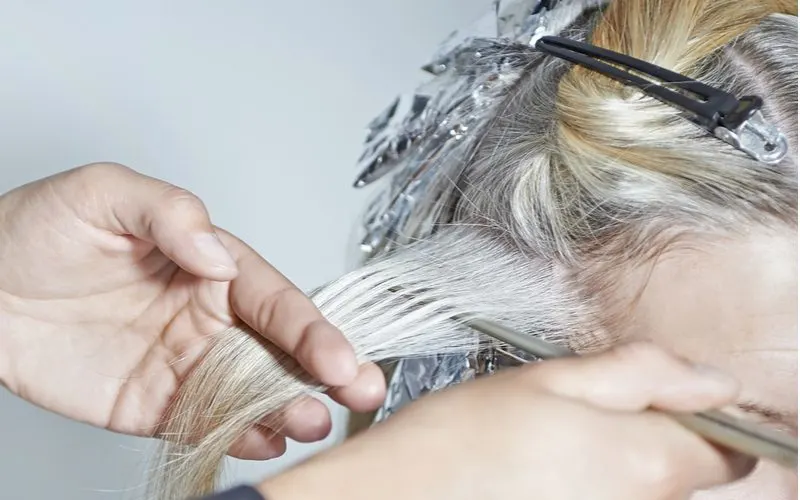
Dennis Jacobsen/Shutterstock
Ma’am, I’m gonna have to ask you to slowly back away from the bleach and put away that developer. If you’ve found yourself in the middle of a certified hair disaster, you may be tempted to try and bleach your way out of it. But bleaching again too soon is the worst thing you can do to your hair right now.
So, how often can you bleach your hair safely without damaging it?
To avoid breakage, hair loss, and damaging your hair’s inner structures, you can’t bleach it back-to-back. Even if you hate the way it looks right now. Even if there’s an important event coming up. Even if you think your hair is healthy enough to withstand the damage of BleachFest: Round 2 (it’s not).
No matter what, your hair needs a short recovery period in between harsh chemical processes like bleaching, coloring, or perming. Bleaching your hair even one time damages it to some extent. Can you imagine what can happen to your hair when you bleach it more than once in a short time period?
Sure. We’ve all seen videos where women end up bleaching their hair twice (or more!) in a single day. Maybe you’ve done it yourself in the past. Usually, bleaching a second or third time is a desperate attempt to fix something that went wrong in the DIY lightening process the first time around.
Most of the time, the repeated bleaching we see in DIY videos leaves the person’s hair in a severely damaged mushy or brittle state.
Occasionally, we see the really scary consequences of over-processing, like sudden breakage, noticeable hair loss, a strange gooey/gummy hair texture, and untameable brittleness, dryness, and frizz.
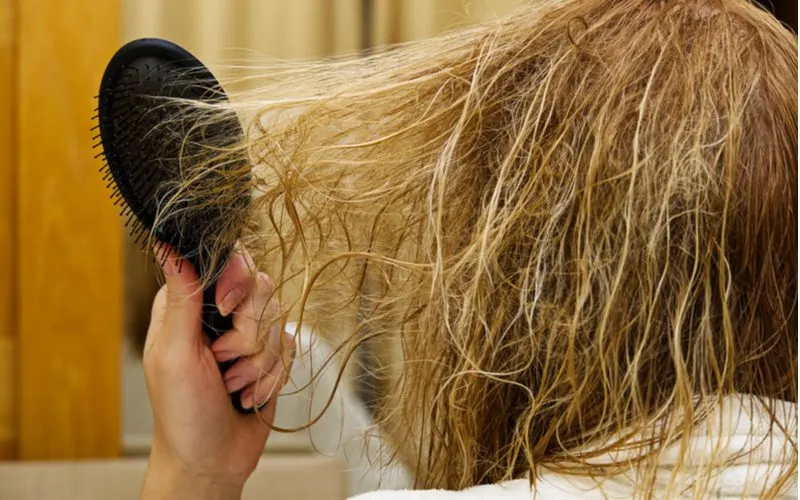
VidEst/Shutterstock
It ain’t pretty, folks.
Trust us. The consequences of bleaching your hair again too soon are a lot worse than dealing with a color you don’t like for a couple of weeks.
Don’t let this happen to you! By informing yourself about how often you can safely lighten your hair with bleach, you can avoid all the problems that come along with over-processing and chemical damage.
Check out the essential info below to keep your lightened locks looking luscious! We’ll talk about how often you can safely bleach your hair all-over and for quick root touch-ups. We’ll also share details about the consequences of bleaching your hair back-to-back. Let’s get started!
Read Next: How to Lighten Hair Without Bleach
What Happens If You Bleach Your Hair Too Often?
Bleaching back-to-back poses a number of serious risks to the health, strength, and integrity of your hair. It’s an extremely aggressive process for your hair and scalp. Before we talk about the consequences of bleaching too often, let’s look at a quick overview of how the bleaching process works.
How the Bleaching Process Works
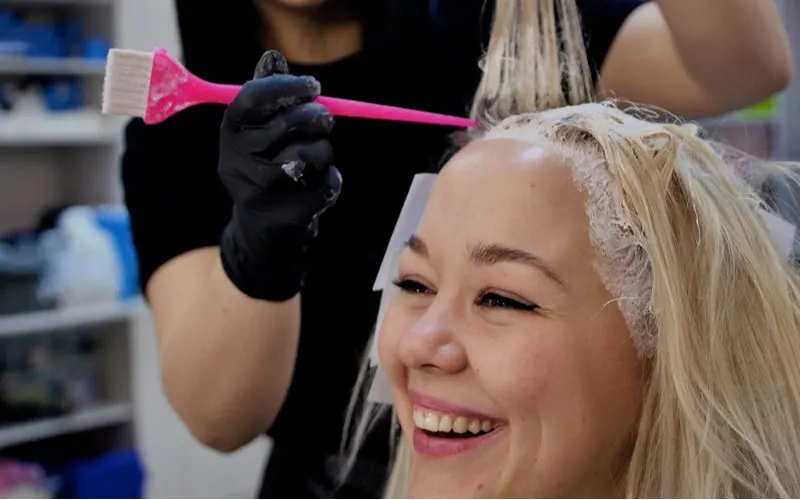
Ekaterina Byuksel/Shutterstock
When you use bleach to lighten your hair, the chemicals will work together to penetrate the hair shaft and oxidize the natural melanin pigments in your hair. As the bleach oxidizes your hair’s natural pigments, they get lighter and lighter until they reach a nearly-colorless, pale yellow tone.
But bleach powder alone doesn’t lighten your hair. It has to be mixed with a developer to give you the lighter hair color you want.
Hydrogen peroxide, one of the active ingredients in most developers, literally pries open the cuticle scales or plates that make up the outer layer of your hair. Once those little scales are lifted up, the bleach can make its way into the hair shaft and start oxidizing the melanin pigments in your strands.
Once you apply the bleach and developer mixture to your hair, it has to stay there for a bit to process. It takes time and heat for bleach to effectively lighten your hair color. Most of the time, you’ll leave the bleach mixture on your hair for anywhere from 10-30 minutes.
At home, you might use a shower cap to trap your body heat and speed up your processing time. In a salon, your stylist will likely put you under a dryer to help your hair process even faster.
As you’re probably thinking (or have already discovered), a lot can go wrong during the bleaching process.
- If you don’t evenly apply the mixture or fail to fully saturate the hair with it, the results could look spotty, patchy, or uneven. Bleach can only lighten hair it is directly applied to, so missing spots during application gives you patchy results. Bleach that is applied too thinly dries out quickly. If the bleach mixture is allowed to dry on the hair, it stops working and won’t fully lighten your hair.
- If you leave the bleach mixture on too long, your hair will be over-processed and visibly damaged. You may notice a gummy or mushy texture, sudden breakage and hair loss, or even what stylists refer to as a “chemical haircut.” This is when the protein bonds in your hair are broken so irreparably that the hair just snaps right off wherever the bleach was applied.
- If you don’t leave the bleach mixture on long enough, your hair will be under-processed and won’t turn out as light as you wanted. The result is usually warm, brassy hair with red, orange, or yellow undertones peeking through. If you only left the bleach for a short period of time, you may not achieve any lift in the color at all.
And if you bleach your hair again immediately afterward to try and fix any of these mistakes, you’ll only make the problem worse. Much worse.
Read Next: How to Get Rid of Brassiness in Hair
Why Bleaching Your Hair Again Too Soon is Dangerous
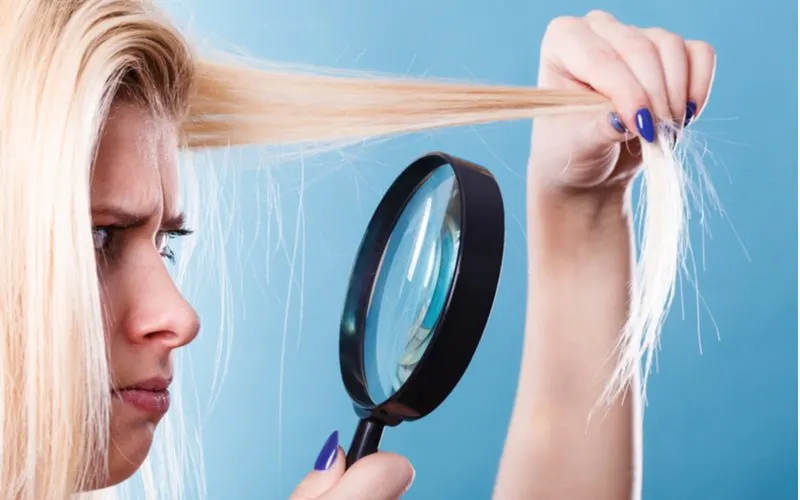
Anetlanda/Shutterstock
Bleaching your hair again too soon is downright dangerous for your hair and scalp. We’ve talked about the bleach process and how it works. If you put your locks through this damaging, harsh process again without a sufficient “recovery period,” there’s a good chance your hair will be damaged beyond repair.
Any damage done during the first bleaching session will be compounded by a second round. So, if the first round leaves your hair a little dry, frizzy, and fragile, you can bet that Round 2 will leave your hair extremely brittle, bone-dry, and prone to breaking or falling out.
Above, we shared how bleach and developer work together to penetrate inside strands and lighten your hair color.
During that process, the outermost layer of the hair (the cuticle layer) gets forced open by the hydrogen peroxide in the developer so the bleach molecules can make their way inside.
Since the hair’s cuticle scales aren’t meant to be pried open like this, this part of the process leaves your hair quite vulnerable to damage and moisture loss. But that’s not all!
After you finish bleaching and rinse the mixture out, your hair doesn’t just magically get restored to its pre-bleach state. The cuticle scales will stay partially lifted and it takes a couple of weeks for them to recover.
If you bleach again too soon, you risk breaking off those cuticle cells entirely, exposing the fragile inner structures of your hair.
If you’ve ever dealt with split ends, you know what hair missing its cuticle layer looks and feels like. Split ends occur when the cuticle layer is eroded at the tips of the strands. So imagine if the cuticle layer is chemically broken all over your head! That’s what can happen with repeated bleaching.
The inner structures of your hair, the cortex and medulla, will also be weakened and fragile after being exposed to harsh chemicals back-to-back. This weak, fragile hair will break off easily and may fall out at the root.
This is why it is 100% essential to give your hair a couple of weeks “off” in between bleaching sessions. Your hair needs time to recover!
How Often Can You Bleach Your Hair All-Over?
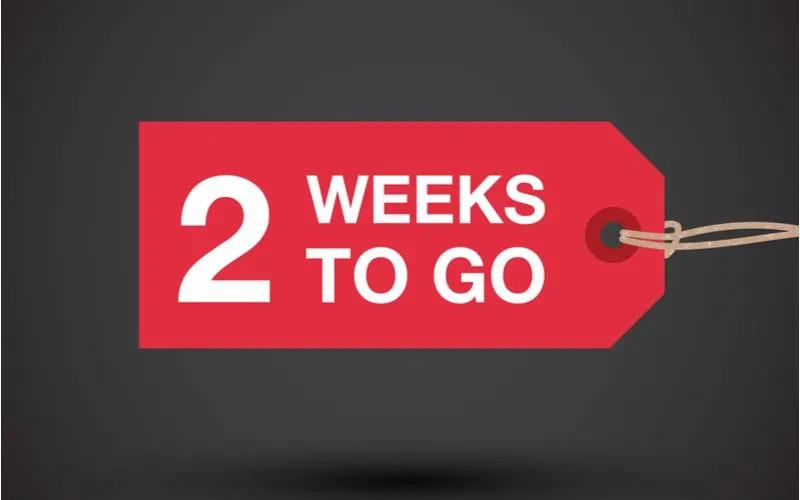
James Weston/Shutterstock
Let’s say you’ve bleached your hair and the results didn’t quite turn out like you expected. You realize you’ve missed a few spots, didn’t achieve the level of lift you wanted, or ended up with super-warm tones (like red, orange, or yellow) showing through.
You decide you’ll need to do a second round of bleach to achieve the results you want (or that you can at least live with). But the issue with bleaching again immediately is the damage it will cause. So how often can you bleach your hair all-over?
You should be able to safely bleach your hair again in about 2 weeks. Two weeks isn’t a lot of time, but it does give your strands a little window of recovery in between harsh bleaching sessions.
This gives your cuticle layer time to relax and lay back down to better protect the inner structures of your hair strands. With an intact cuticle layer, your hair will be better moisturized, less porous, and more resistant to damage from the second round of bleach.
It’s important to note that 2 weeks is the minimum amount of time you should wait before bleaching your entire head again. The longer you can wait, the better off your hair will be.
So if you make it 2 weeks and have grown to like your color or find that braids, hats, or updo styles hide the spotty color well enough, you may as well hold out for another week or two before bleaching again. Any additional recovery time will be worth it for the sake of your hair’s health.
How Often Can You Bleach Your Roots?
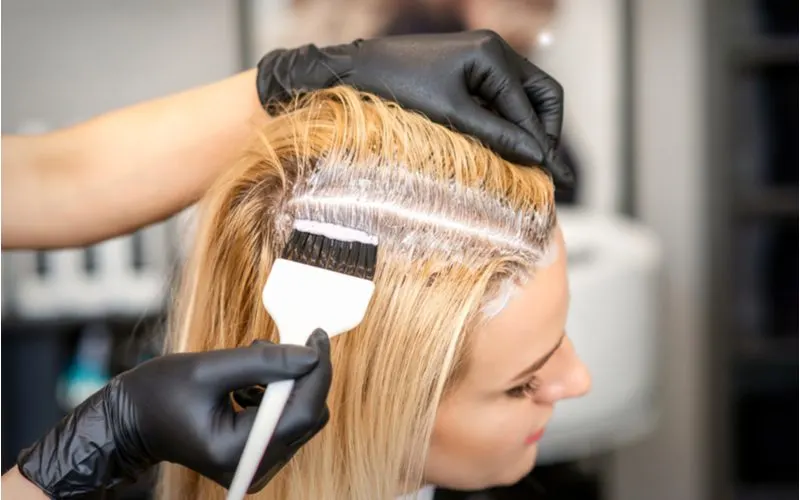
Michelle Aleksa/Shutterstock
If you’re fully bleached or have significant highlights, you may be wondering how often you can bleach your roots for touch-ups. The good news is that you should be able to bleach your roots as soon as they begin to show – around 4 to 6 weeks.
Depending on the rate your hair grows, you may not need to touch up your roots that soon. Some women report needing a root touch-up every 6-8 weeks.
Touching up your roots with bleach isn’t as damaging to your hair as bleaching your entire head. When you do a bleach root touch-up, you’re only applying bleach to the newly grown virgin hair that hasn’t yet been chemically processed.
So when you bleach these new roots, you’re bleaching fresh, undamaged, and (hopefully) healthy hair. This means you can bleach your roots as soon as they become unsightly without risking further damage to your hair.
If you’re sick of doing root touch-ups every 4-8 weeks, consider moving toward a shadow root/balayage look instead. This allows you to leave your roots unbleached while softly blending the darker roots in with the lighter, hand-painted highlights that start around the mid-shaft.
Things to Consider
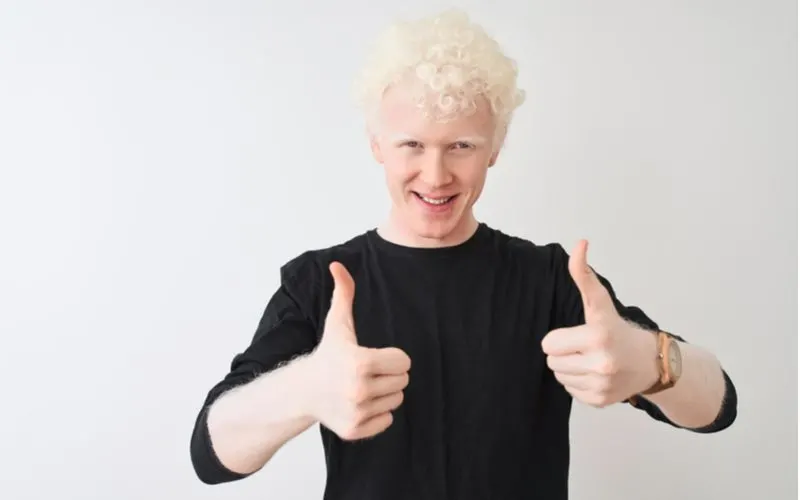
Krakenimages/Shutterstock
If you’re smart, you can use the minimum 2-week recovery period between bleaching sessions to really pamper and baby your hair. This recovery period is the time to ensure your hair has all the nutrients and damage-repairing protein it needs to bounce back after bleaching.
There are also simple steps you can take to correct the color and tone it without using more bleach during this critical waiting period. Let’s take a look at the things you should consider while you wait until it’s okay to bleach again.
While You Wait…
- Use a bond-strengthening protein hair treatment like Olaplex Hair Perfector No. 3 Hair Repairing Treatment once or twice a week to repair some of the damage and get your hair in better shape before bleaching again.
- Use a moisturizing hair mask to hydrate your thirsty strands and restore some of the moisture lost during the bleaching process. Find a list of our favorites here: Best Hair Mask: 7 Products That Actually Work.
- Lay off the heat for a while to give your locks time to heal. Heat styling can compound the chemical damage done to your hair, so opt to air-dry your hair for the next couple of weeks and choose no-heat styles to give your hair a much-needed break. If you do use hot tools during the recovery period, make sure to use a good heat protectant first.
- Use toning shampoo if your hair is light enough, but looks brassy or has unwanted warm tones showing through. Purple shampoo works for blonde and silver hair, while blue shampoo is designed to tone orange out of brunette colors.
- Apply a demi-permanent toner to correct the color in the meantime. This is a gentler option than bleaching again and can help you achieve a perfectly balanced color without brassy tones. Blue toners neutralize orange tones, Violet toners neutralize yellow tones, and Blue-Violet toners neutralize brassy tones between yellow and orange.
- Find a stylist you can trust. If you’ve been going at it alone so far with mixed or bad results, now is a great time to start searching for a good stylist to hand the baton to. Do some research to find the best stylist within your budget near you. Then, when you’re ready to bleach again, you’ll be able to leave the hard work to your new stylist and get the results you’re looking for.
Finally, consider the overall health of your hair before you decide it’s okay to bleach it again. If your hair feels brittle, dry, extremely frizzy, mushy, gummy, or breaks off easily after your first bleaching session, you’re going to need to hold off a lot longer than someone whose hair is less damaged.
Two weeks is the minimum amount of time you should wait before bleaching your hair again, but if you can wait a month or two, that’s going to be much better for your strands.
How often can you bleach your hair? Technically, you could bleach it over and over if you wanted to – but it will get fried and fall out in the process. To keep your hair healthy and minimize the damage, don’t ever bleach your hair more than once in a two-week period.
Make sure to take steps to repair any damage done with hair treatments, masks, and no heat styling for a few weeks afterward. The process may be frustrating, but your strands will thank you.
